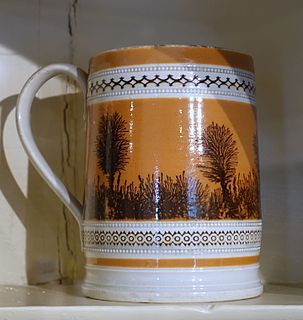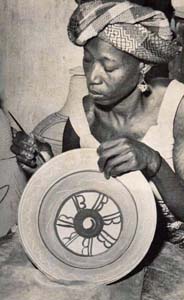
Bolesławiec is a historic city situated on the Bóbr River in the Lower Silesian Voivodeship, in western Poland. It is the administrative seat of Bolesławiec County, and of Gmina Bolesławiec. As of June 2021, it has a population of 38,280. Founded in the 13th century, the city is known for its long-standing pottery-making tradition and heritage Old Town.

Stoneware is a rather broad term for pottery or other ceramics fired at a relatively high temperature. A modern technical definition is a vitreous or semi-vitreous ceramic made primarily from stoneware clay or non-refractory fire clay. Whether vitrified or not, it is nonporous ; it may or may not be glazed. Historically, around the world, it has been developed after earthenware and before porcelain, and has often been used for high-quality as well as utilitarian wares.

Thomas Whieldon was a significant English potter who played a leading role in the development of Staffordshire pottery.

Guilloché is a decorative technique in which a very precise, intricate and repetitive pattern is mechanically engraved into an underlying material via engine turning, which uses a machine of the same name, also called a rose engine lathe. This mechanical technique improved on more time-consuming designs achieved by hand and allowed for greater delicacy, precision, and closeness of line, as well as greater speed.

William Frend De Morgan was an English potter, tile designer and novelist. A lifelong friend of William Morris, he designed tiles, stained glass and furniture for Morris & Co. from 1863 to 1872. His tiles often recall medieval or Islamic design patterns. He applied innovative glazes and firing techniques. Galleons and fish were common motifs, as were "fantastical" birds and animals. Many of De Morgan's tiles were designed to create intricate patterns when several were laid together.

Slipware is pottery identified by its primary decorating process where slip is placed onto the leather-hard (semi-hardened) clay body surface before firing by dipping, painting or splashing. Slip is an aqueous suspension of a clay body, which is a mixture of clays and other minerals such as quartz, feldspar and mica. The slip placed onto a wet or leather-hard clay body surface by a variety of techniques including dipping, painting, piping or splashing. Slipware is the pottery on which slip has been applied either for glazing or decoration. Slip is liquified clay or clay slurry, with no fixed ratio of water and clay, which is used either for joining pottery pieces together by slip casting with mould, glazing or decorating the pottery by painting or dipping the pottery with slip.

Creamware is a cream-coloured refined earthenware with a lead glaze over a pale body, known in France as faïence fine, in the Netherlands as Engels porselein, and in Italy as terraglia inglese. It was created about 1750 by the potters of Staffordshire, England, who refined the materials and techniques of salt-glazed earthenware towards a finer, thinner, whiter body with a brilliant glassy lead glaze, which proved so ideal for domestic ware that it supplanted white salt-glaze wares by about 1780. It was popular until the 1840s.

Jasperware, or jasper ware, is a type of pottery first developed by Josiah Wedgwood in the 1770s. Usually described as stoneware, it has an unglazed matte "biscuit" finish and is produced in a number of different colours, of which the most common and best known is a pale blue that has become known as Wedgwood Blue. Relief decorations in contrasting colours are characteristic of jasperware, giving a cameo effect. The reliefs are produced in moulds and applied to the ware as sprigs.

A rose engine lathe is a specialized kind of geometric lathe. The head stock rocks back and forth with a rocking motion and/or slides along the spindle axis in a pumping motion. A rosette or cam-like pattern mounted on the spindle is controlled by moving against a cam follower(s) while the lathe spindle rotates. Rose engine work can make flower patterns, as well as convoluted, symmetrical, multi-lobed geometric patterns. The patterns it produces are similar to that of a Spirograph, in metal. No other ornamental lathe can produce these "rose" patterns. The decoration produced by a rose engine lathe is called guilloche. It sometimes confused with "jewel finishes" or engine turning, a much cheaper process of making swirly marks in metal by a rotating abrasive peg or pad, which is repeatedly applied to the surface to make a pattern of overlapping circles. Jewel finishes used to be common on stereo faceplates and automobile interiors.

Wedgwood is an English fine china, porcelain and luxury accessories manufacturer that was founded on 1 May 1759 by the potter and entrepreneur Josiah Wedgwood and was first incorporated in 1895 as Josiah Wedgwood and Sons Ltd. It was rapidly successful and was soon one of the largest manufacturers of Staffordshire pottery, "a firm that has done more to spread the knowledge and enhance the reputation of British ceramic art than any other manufacturer", exporting across Europe as far as Russia, and to the Americas. It was especially successful at producing fine earthenware and stoneware that were accepted as equivalent in quality to porcelain but were considerably cheaper.

Mintons was a major company in Staffordshire pottery, "Europe's leading ceramic factory during the Victorian era", an independent business from 1793 to 1968. It was a leader in ceramic design, working in a number of different ceramic bodies, decorative techniques, and "a glorious pot-pourri of styles - Rococo shapes with Oriental motifs, Classical shapes with Medieval designs and Art Nouveau borders were among the many wonderful concoctions". As well as pottery vessels and sculptures, the firm was a leading manufacturer of tiles and other architectural ceramics, producing work for both the Houses of Parliament and United States Capitol.

Saint-Porchaire ware is the earliest very high quality French pottery. It is white lead-glazed earthenware often conflated with true faience, that was made for a restricted French clientele from perhaps the 1520s to the 1550s. Only about seventy pieces of this ware survive, all of them well known before World War II. None have turned up in the last half-century. It is characterized by the use of inlays of clay in a different coloured clay, and, as Victorian revivalists found, is extremely difficult to make.

A slip is a clay slurry used to produce pottery and other ceramic wares. Liquified clay, in which there is no fixed ratio of water and clay, is called slip or clay slurry which is used either for joining leather-hard (semi-hardened) clay body together by slipcasting with mould, glazing or decorating the pottery by painting or dipping the pottery with slip. Pottery on which slip has been applied either for glazing or decoration is called the slipware.

Mocha decorated pottery is a type of dipped ware, mocha or mochaware, in addition to colored slip bands on white and buff-colored bodies, is adorned with dendritic markings resembling the natural geological markings on moss agate, known as "mocha stone" in Great Britain in the late 18th century. The stone was imported from Arabia through the port of Mocha from whence came large supplies of coffee. An unknown potter or turner discovered that by dripping a colored acidic solution into wet alkaline slip on a pot body, the color would instantly ramify into the dendritic random markings that fit into the tradition of imitating geological surfaces prevalent in the potteries of that period. The earliest known dated example (1799) is a mug in the collection of the Christchurch Mansion Museum in Ipswich, England. Archaeological excavations of the wreck of HMS Nymphe in Road Town Harbor on Tortuga in the British West Indies produced sherds of two earthenware vessels with dendritic markings on slip marbled surfaces. The sloop was accidentally burned and sunk in 1783, giving an earlier date for this technique provided the sherds are from that wreck. The context appears to support that supposition. Archival references are known that mention "mocoe beakers" as early as 1792.

Ladi Kwali, OON, MBE was a Nigerian potter, ceramicist and educator.

Cizhou ware or Tz'u-chou ware is a term for a wide range of Chinese ceramics from between the late Tang dynasty and the early Ming dynasty, but especially associated with the Northern Song to Yuan period in the 11–14th century. It has been increasingly realized that a very large number of sites in northern China produced these wares, and their decoration is very variable, but most characteristically uses black and white, in a variety of techniques. For this reason Cizhou-type is often preferred as a general term. All are stoneware in Western terms, and "high-fired" or porcelain in Chinese terms. They were less high-status than other types such as celadons and Jun ware, and are regarded as "popular", though many are finely and carefully decorated.

Ceramic art is art made from ceramic materials, including clay. It may take forms including artistic pottery, including tableware, tiles, figurines and other sculpture. As one of the plastic arts, ceramic art is one of the visual arts. While some ceramics are considered fine art, such as pottery or sculpture, most are considered to be decorative, industrial or applied art objects. Ceramics may also be considered artefacts in archaeology. Ceramic art can be made by one person or by a group of people. In a pottery or ceramic factory, a group of people design, manufacture and decorate the art ware. Products from a pottery are sometimes referred to as "art pottery". In a one-person pottery studio, ceramists or potters produce studio pottery.

William Greatbatch was a noted potter at Fenton, Staffordshire, from the mid-eighteenth to the beginning of the nineteenth centuries. Fenton was one of the six towns of the Staffordshire Potteries, which were joined in the early 20th century to become the city of Stoke-on-Trent in Staffordshire, England.

The original Castleford Pottery operated from c. 1793 to 1820 in Castleford in Yorkshire, England. It was owned by David Dunderdale, and is especially known for making "a smear-glazed, finely moulded, white stoneware". This included feldspar, giving it a degree of opacity unusual in a stoneware. The designs typically included relief elements, and edges of the main shape and the panels into which the body was divided were often highlighted with blue overglaze enamel. Most pieces were teapots or accompanying milk jugs, sugar bowls and slop bowls, and the shapes often derived from those used in contemporary silversmithing.

Millicent (Millie) Jane Taplin (1902–1980) was a British designer and painter of ceramics who spent most of her career at Josiah Wedgwood and Sons (1917–1962). She was trained in painting by Alfred and Louise Powell, and supervised Wedgwood's ceramics painters. She became a designer of decorative patterns in 1929 and by the mid-to-late 1930s was one of the company's main designers, although she did not design pottery shapes. She was one of only two working-class women to become a successful ceramics designer before the Second World War. Her tableware designs were exhibited by Wedgwood at Grafton Galleries in London in 1936, and several of her designs are now on display at the V&A Museum. Her design "Strawberry Hill", with Victor Skellern, was awarded the Council of Industrial Design's Design of the Year Award in 1957.





















